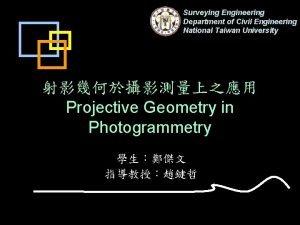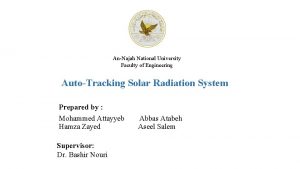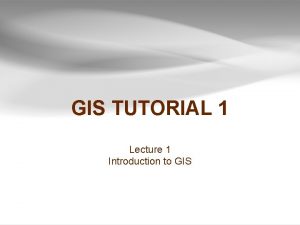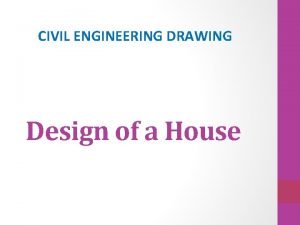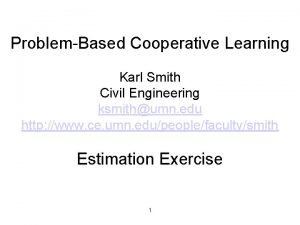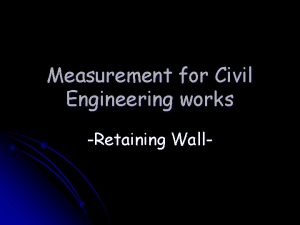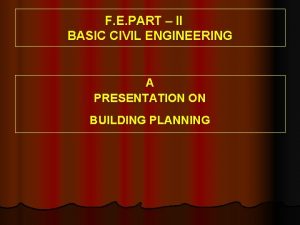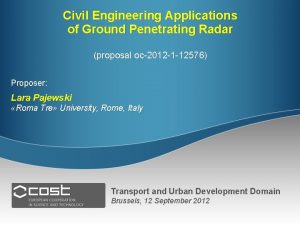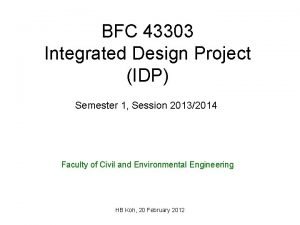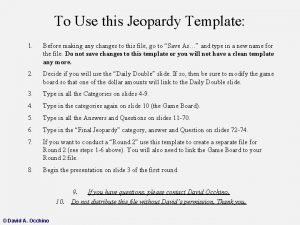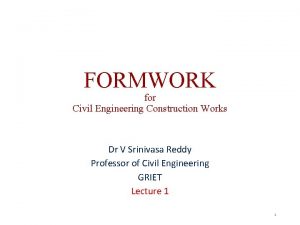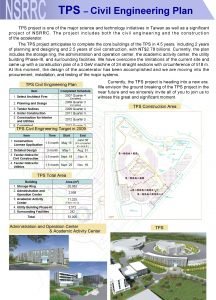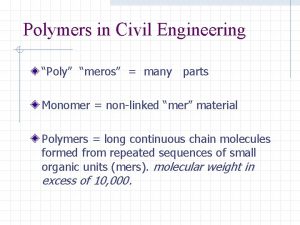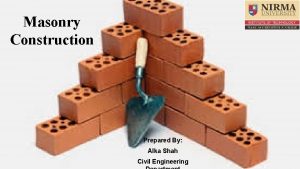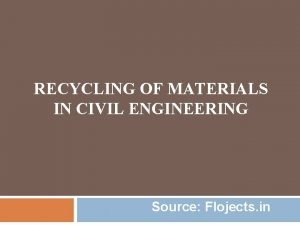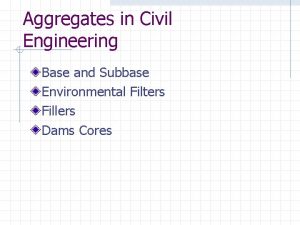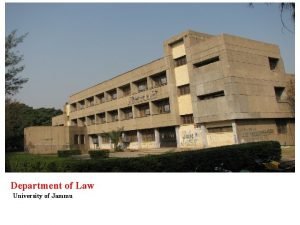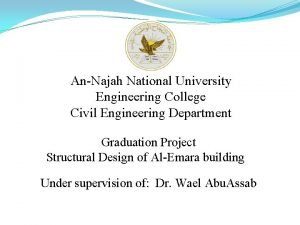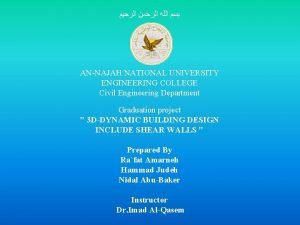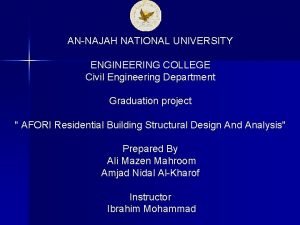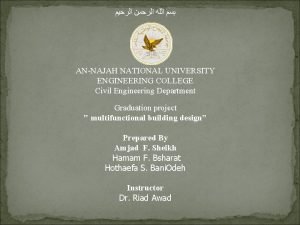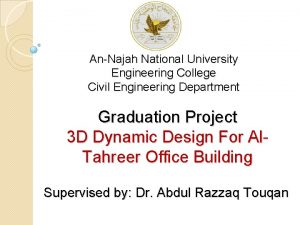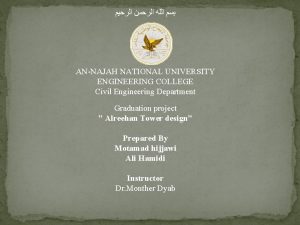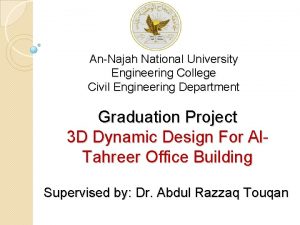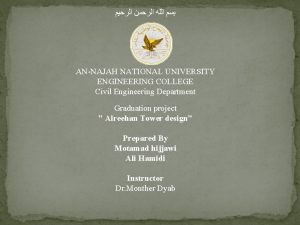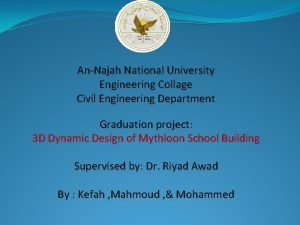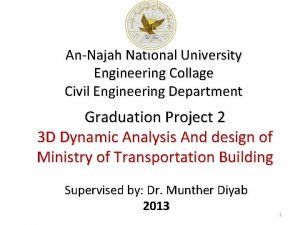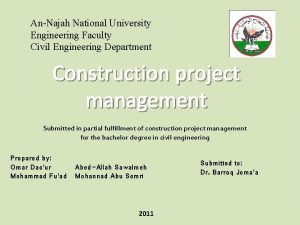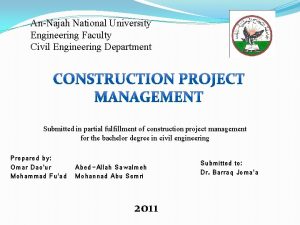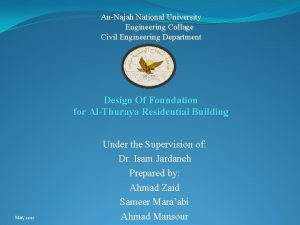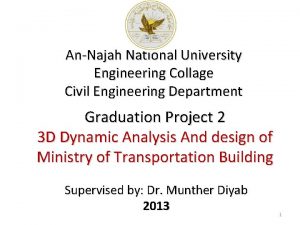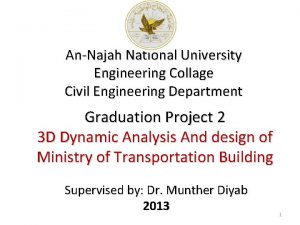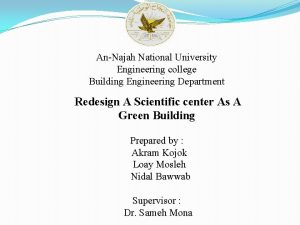ANNAJAH NATIONAL UNIVERSITY ENGINEERING COLLEGE Civil Engineering Department











































![Check for buckling * check buckling: Check if column is short or long [(K*Lu)/r] Check for buckling * check buckling: Check if column is short or long [(K*Lu)/r]](https://slidetodoc.com/presentation_image_h2/152f030ad0c07df792f015bd89b8a55e/image-44.jpg)












- Slides: 56

ﺑﺴﻢ ﺍﻟﻠﻪ ﺍﻟﺮﺣﻤﻦ ﺍﻟﺮﺣﻴﻢ AN-NAJAH NATIONAL UNIVERSITY ENGINEERING COLLEGE Civil Engineering Department Graduation project " Alreehan Tower design" Prepared By Motamad hijjawi Ali Hamidi Instructor Dr. Monther Dyab

3 D of the building

Abstract The main aims of the project are to analyze and design all parts of the structure and determine the right and economical ways to solve the Problems facing the process.

our project is alreehan tower, 12 stories: We choose: *The frame structure as a structural system to design according it Because we just have beams, columns and slabs which distributes symmetrically with no inclined ones. * The concrete and reinforced concrete as a material for building, this is the available material we can use in state of our available technology here in Palestine

a mass active topology in order to have a high capability to resist high bending and positive and negative pressure of compression to be insitue preferable . * The form of 2 D & 3 D and curves of zero elastic ones to use it in application of beams and floors

Overview Al-reehan towers it is two building with the same foundation , we redesign just one of these This project is a design of an residential building which located in Ramallah city. This building is consisted of twelve stories. The building designed under a static load by SAP 2000 v. 14 program

Contents Chapter One: Introduction 1 -1 About the project 1 -2 Philosophy of analysis & design 1 -3 Materials 1 -4 Loads 1 -5 Codes Chapter Two: Design of floor system 2 -1 Slab systems 2 -2 Floor system 2 -3 Thickness of the slab 2 -4 Design of rib 2 -5 Shear design of rib

Contents Chapter Three: Beams 3 -1 Beams system 3 -2 Shear design of beams Chapter Four: Columns 4 -1 Column system 4 -2 Groups design

Contents Chapter Five : Foundations 5 -1 footing system 5 -2 design of mat foundation 5 -3 footing thickness & design for flexure Chapter Six: Shear walls 6 -1 Walls system 6 -2 walls reinforcement

INTRODUCTION About the project: The building located in Ramallah, is a residential building consists of twelve floors having approximately the same area (448 m 2) and height(3. 1 m). Philosophy of analysis & design: -The building is considered as reinforced concrete structure with walls all around. In this project, the structure will be analyzed and designed using software SAP 2000 version 14. -Ultimate design method is used to design the building.

INTRODUCTION Materials of construction: Ø Reinforced concrete: unit weight= 25 KN/m 3 f’c = 28 MPa Fy =420 MPa Block density = 12 KN/m 3 Stone density =18 KN/m 3

INTRODUCTION loads: Its gravity load consist of: Live load: it comes from the people, machines and any moveable objects in the building. The amount of live depends on the type of building or structure. load In this project the live load is (3 k. N/m 2) for all floors. Dead load: Owen weight=(Calculated By SAP)

Superimposed Load: This weight per unit area depends on the type of finishing which is usually made of Tiles (2. 5 cm thick) =0. 025× 24 = 0. 6 k. N/m 2 Cement mortar (2. 5 cm thick) =0. 025× 23 = 0. 575 k. N/m 2 Sand fill (10 cm thick) =0. 1× 18 = 1. 8 k. N/m 2 Plaster (2 cm thick) =0. 02× 23 = 0. 46 k. N/m 2 Equivalent partition weight = 1 KN/m 2 Superimposed Load =4. 5 KN/m 2

INTRODUCTION Code Used: American Concrete Institute Code (ACI 318 -05) Combination: Ultimate load= 1. 2 D+1. 6 L

SLAB One-way slabs: When the ratio of the longer to the shorter side (L/ B) of the slab is at least equal to 2. 0, it is called one-way slab One-way ribbed slabs: If the ribs are provided in one direction only, the slab is classified as being one-way, regardless of the ratio of longer to shorter panel dimensions.

One way ribbed slab is used only in this structure :

SLAB To control deflection, ACI Code specifies minimum thickness values for one-way ribbed slabs For this project thickness of slab: hmin = Ln/18. 5 =4. 78/18. 5=22. 76 cm but h not good for shear resistance and for the design of hidden beams Use h=30 cm.

cross section in ribbed slab

Shear resistance: According to ACI Code shear strength provided by rib concrete Vc may be taken 10% greater than those for beams. = 21. 8 KN

Design of rib : There are six groups of rib in the floor plan as shown in figure

SLAB Design of Slab : Rib 1 :

ρ Negative moment design for Rip 1. Mu (KN. m) d (mm) b (mm) P As (mm 2) Asmin (mm 2) 0 250 8. 44 15. 34 since use As (mm 2) n db 120 0 0 100 As<Asmin 100 2 10 250 120 0. 0031 91. 6 100 As<Asmin 100 2 10 250 120 0. 0057 170. 6 100 As>Asmin 170. 618 2 12 Positive moment design for Rip 1. Mu (KN. m) d (mm) b (mm) 1. 22 250 520 6. 39 250 520 p 1 E-04 0. 000 5 As (mm 2) Asmin (mm 2) since use As (mm 2) n db 12. 70 100 As<Asmin 100 2 10 67. 81 100 As<Asmin 100 2 10

SLAB Design of Slab : Rib 4 :

Most ribs have steel bar 2ᶲ 12 in upper and steel bar 2ᶲ 10 in bottom

BEAMS Beams are usually designed to carry the following loads: - Their own weight -Weights of partitions applied directly on them -Floor loads Beams in this part of the project will be designed using Tributary area method. All of beams are hidden

Design of the floor: There is many beams are used to carry slab as shown in figure

BEAMS Design of beam 1: D. L= L. L= × 5. 1=4. 85 KN/m × 3=2. 85 KN/m D. L(KN/m) L. L(KN/m) S. D. L= × 4. 5+22. 5=26. 78 KN/m S. D. L(KN/m)

In order to get efficient results two models are considered to represent the existing condition, which are the fixed and hinged cases at the ends. Hinged case at the end: S. F. D (KN) B. M. D (KN. m) Fixed case at the end: S. F. D (KN) B. M. D (KN. m)

Positive moment design for beam (b 1). Mu fixed (KN. m) Mu hinged (KN. m) Mu average (KN. m) d (mm) b (mm) P As (mm 2) Asmin (mm 2) Since use As (mm 2) select 73. 67 223. 68 148. 68 240 600 0. 0128 1845 480 As>Asmin 1845 6 Ф 20 Negative moment design for beam (b 1). Mu fixed (KN. m) Mu hinged (KN. m) Mu average (KN. m) d (mm) b (mm) 150. 01 0 75. 005 240 600 P As (mm 2) Asmin (mm 2) 0. 0061 872 480 since use As (mm 2) select As>Asmin 872 4 Ф 18 Shear design for beam (b 1): Ultimate shear at the critical section (at distance d from the face of support) is equal to: Vu = 135. 33 KN. Vn = (Vu/ 0. 75) = 180. 44 KN. Vc = (1/6)(fc)0. 5 *bw *d = 127 KN. Vs = Vn – Vc = 53. 44 KN. Vs max = 4(Vc) = 508 KN Vs ≤ Vs max ----------- OK (Av/S) = 0. 53 (Av/S) min = 0. 5 (Av/S) ≥ (Av/S) min ---------- OK Use 8 mm diameter stirrups: S = 189. 55 mm, here Vs ≤ 2 Vc, so S max. = min. (600 mm & d/2) Use S = 120 mm

The other Beams have been working in the same way as in the last

COLUMNS

We will design the column of this structure against earthquake There are three methods to perform analysis and design of earthquake: 1 -Time history. 2 -Response spectrum. 3 -Equivalent static. In this project dynamic analysis and design will be done using the Response spectrum method

From the map the response spectral Values Ss, S 1 are found for Ramallah City as Approximately 27 and 7 percent Figure 1 Hazard map of Palestine in terms of earthquake response spectral acceleration in g, for 475 years return period and damping ratio of 5% computed for periods: a) 0. 2 sec; and b) 1 sec

I: seismic factor (importance factor) = 1. 25 The approximate parameter Ct and x are 0. 02 and 0. 75 for this structural system The Site class can found as B for rock soil profile This all information will put in sap 2000 for analysis and design

Dynamic Design


Load combination 1. added default design combination by sap the concrete frame design 2. taking the envelope of the combinations

Columns grouping

ID from grid

Columns dimensions We have two design dimensions: First one: given by architectural engineer These dimensions are preliminary and it have some problems that we cant put the area of steel(bars) in these dimensions as specified in ACI code and it have high value of percent of steel

The second: we assume other dimensions We increase the dimensions of columns in order to make it possible to distribute bars with spacing within ACI code limits & Decrease the values of steel percentage to be nearby the economical percent

Two designs comparison

Groups design 4. 2. 1 Design column in group 1: Pu = 4795 KN Pn max = ( 4795/0. 65 ) = 7377 KN Pn max = 0. 8 [ 0. 85*fc~*(Ag – As ) + Fy*As ) 7377*1000 = 0. 8 [ 0. 85 * 28 *( 400*800 - As ) + 420*As As = 4052 mm 2 ρ= As/Ag = ( 4052)/(400*800) = 1. 26 % > ρmin=1% ………………. OK Use 14 Ф 20 mm (As=4396 mm 2)
![Check for buckling check buckling Check if column is short or long KLur Check for buckling * check buckling: Check if column is short or long [(K*Lu)/r]](https://slidetodoc.com/presentation_image_h2/152f030ad0c07df792f015bd89b8a55e/image-44.jpg)
Check for buckling * check buckling: Check if column is short or long [(K*Lu)/r] < [34 – 12(M 1/M 2)] ………… for short column K = 0. 75 , Lu = (3. 1 – 0. 06) , r = 0. 3 h = 0. 3*0. 8 = 0. 24 , M 1 = M 2 (0. 75 * 3. 04)/ 0. 24= 9. 5 , 34 -12(1)=22 So , [(K*Lu)/r] < [34 – 12(M 1/M 2)] ………………… OK Pcr = π2 EI / (KL)2 EI = (0. 4 * EC * Ig ) / (1 + Bd ) Bd = (1. 2 DL / Pu) = 3676 / 4795 = 0. 767 Ec = 4700 ( 28 )0. 5 = 24870 MPa Ig = ( bh 3)/12 = ( 400*8003)/12 = 1. 71*1010 mm 4 EI = 9. 61*1013 Pcr = π2 (9. 61*1013) / ( ( 0. 75 * 3100 )2 * 1000 ) = 175288 KN 0. 75 Pcr = 131466 KN > Pu …………………. Ok ( no buckling )

* Spaces between ties : - 16 Db = 16 * 20 = 320 mm Or 48 Ds = 48 * 10 = 480 mm Or Least column dimension = 400 mm Take the smaller ……………. . S = 320 mm

Choice of the Type of Foundation The allowable bearing capacity of the soil =300 KN/m 2 , The Summation of service load equal 127677 KN The area of all footing larger than 50% of the base area of structure So the footing will design as mat foundation Mat foundation provided when the soil is having very low bearing capacity and or when columns loads are heavy, the required footing area becomes very large (more than 50 percent of the area) and uneconomical

Assume the mat depth =1. 1 m, the effective depth =1 m For column 1: bo=600+2×(1000/2)+2×(350+1000/2)=3300 mm ᶲVcp=(0. 75/3)×√ 28× 3300× 1000/1000=4365. 5 KN Pu from sap=2838. 6 KN ᶲVcp>Pu ok Critical section in column 1

Moment distribution in X-direction

There are six groups of strip in the mat as shown in figure

1_The maximum positive moment 849. 7 KN. m/m Area of steel =2290 mm 2 <Asmin use As min 3333. 3 mm 2 9ᶲ 22/m 2_The maximum negative moment 773. 1 KN. m/m Area of steel =2079 mm 2<Asmin use As min 3333. 3 mm 2 9ᶲ 22/m • The values of moment in y-direction 1_The maximum positive moment from sap 2000 equal 558. 1 KN. m/m Area of steel =1493 mm 2<Asmin use As min 3333. 3 mm 2 9ᶲ 22/m 2_The maximum negative moment from sap 2000 equal 601 KN. m/m Area of steel =1610 mm 2<Asmin use As min 3333. 3 mm 2 9ᶲ 22/m

SHEAR WALLS

The ultimate axial load on this walls is from the loads from adjoining slab (dead & live ) , reactions of beams, in addition to own weight of walls According to ACI code (14. 5): ФPnw = 0. 55 Фfc/Ag [ 1 – (KLc / 32 h )2] ФPnw : nominal axial load strength of wall. Ag: gross area of section. h: overall thickness of member. K: effective length factor, which less than 1 , conservatively we will consider that K=1. Lc: vertical distance between supports. Ф: strength reduction factor which equal (0. 7). We will design for one meter run of wall, so: Ф=0. 7 , Ag=250 mm X 1000 mm , Lc= 3100 mm , h= 250 mm , K= 1.

NOTE: We notice from this table that ФPnw > Pu for all walls ……. So its safe.

Wall reinforcement: Vertical reinforcement According to ACI code (14. 3. 2): minimum ratio of vertical reinforcement area to gross concrete area shall be 0. 0012 As = 0. 0012 x Ag = 0. 0012 x 250 x 1000 = 300 mm 2 USE Ф 12 mm / 300 mm

Horizontal reinforcement According to ACI code (14. 3. 3) minimum ratio of horizontal reinforcement area to gross concrete area shall be 0. 002 As = 0. 002 x Ag = 0. 002 x 250 x 1000 = 500 mm 2 USE Ф 12 mm / 200 mm

THANK YOU
 Ntu ce
Ntu ce Panti asuhan annajah
Panti asuhan annajah Logo annajah
Logo annajah Annajah motors
Annajah motors Annajah motors
Annajah motors National civil defence college
National civil defence college Czech technical university in prague civil engineering
Czech technical university in prague civil engineering Czech technical university in prague civil engineering
Czech technical university in prague civil engineering Department of information engineering university of padova
Department of information engineering university of padova Information engineering padova
Information engineering padova University of sargodha engineering department
University of sargodha engineering department Seoul national university history
Seoul national university history Civil rights and civil liberties webquest
Civil rights and civil liberties webquest 沈榮麟
沈榮麟 College of engineering, king abdulaziz university
College of engineering, king abdulaziz university Civil air patrol national conference
Civil air patrol national conference Pasadena city college police department
Pasadena city college police department National risk and resilience unit
National risk and resilience unit 6 quality priorities
6 quality priorities Function of national audit department in malaysia
Function of national audit department in malaysia Gsoe9220
Gsoe9220 Hse in civil engineering
Hse in civil engineering Civil engineering insurance policies
Civil engineering insurance policies Applications of grouting
Applications of grouting What is formwork in civil engineering
What is formwork in civil engineering Introduction to civil engineering
Introduction to civil engineering Role of civil engineering
Role of civil engineering Gis applications in civil engineering
Gis applications in civil engineering Civil engg drawing house planning
Civil engg drawing house planning Bisection method application in civil engineering
Bisection method application in civil engineering Umn civil engineering
Umn civil engineering Kambiz farahmand
Kambiz farahmand Concrete retaining wall formwork
Concrete retaining wall formwork What is roominess in civil engineering
What is roominess in civil engineering Civil engineering applications of ground penetrating radar
Civil engineering applications of ground penetrating radar Integrated design project civil engineering
Integrated design project civil engineering Civil engineering faculty
Civil engineering faculty Ub civil engineering flowsheet
Ub civil engineering flowsheet Caace gala
Caace gala Branch of civil engineering
Branch of civil engineering Workability of concrete ppt
Workability of concrete ppt Reconciliation meaning in civil engineering
Reconciliation meaning in civil engineering In civil engineering
In civil engineering Column shuttering work
Column shuttering work Eol jsc nasa gov
Eol jsc nasa gov Tps civil engineering
Tps civil engineering Civil engineering works
Civil engineering works Disadvantages of thermoplastics
Disadvantages of thermoplastics Uh manoa civil engineering checklist
Uh manoa civil engineering checklist Racking back in brick masonry
Racking back in brick masonry Civil engineering source
Civil engineering source Swinburne civil engineering
Swinburne civil engineering Bsg civil engineering
Bsg civil engineering Cement chapter in civil engineering
Cement chapter in civil engineering Department of law university of jammu
Department of law university of jammu Department of geology university of dhaka
Department of geology university of dhaka Narrativistic
Narrativistic
